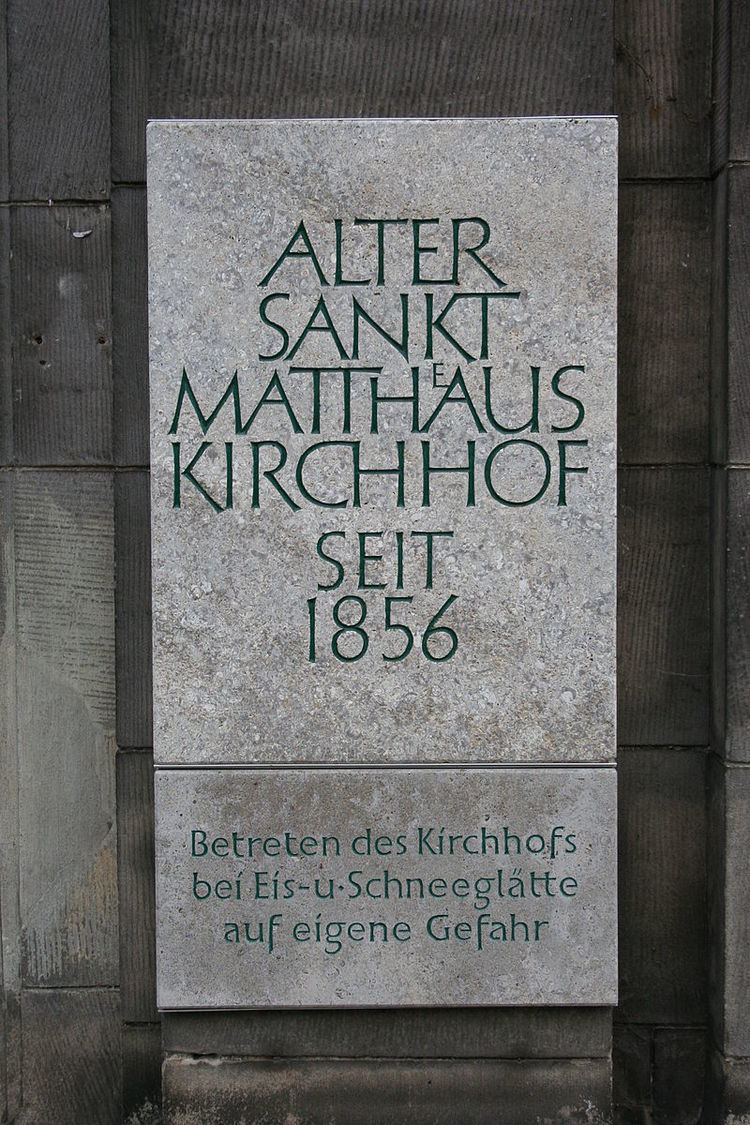Phone +49 30 7811850 | ||
 | ||
Hours Open today · 8AM–5PMMonday8AM–5PMTuesday8AM–5PMWednesday8AM–5PMThursday8AM–5PMFriday8AM–5PMSaturday8AM–5PMSunday8AM–5PM Similar Dorothee Friedhof, Städtischer Friedhof III, Zwölf‑Ap, Ev Friedhof Alt‑Schön, Friedhof Columbia Profiles | ||
Alter St.-Matthäus-Kirchhof (Alter Sankt-Matthäus-Kirchhof or Old St. Matthew's Churchyard) is a cemetery in Schöneberg, Berlin, Germany. It was established in 1856 by the Protestant parish of St. Matthew. It is known for its interment of the Brothers Grimm, Jacob and Wilhelm Grimm, folklore tellers of "Cinderella" ("Aschenputtel"), "The Frog Prince" ("Der Froschkönig"), "Hansel and Gretel" ("Hänsel und Gretel"), "Rapunzel", "Rumpelstiltskin" ("Rumpelstilzchen"), and "Snow White" ("Schneewittchen"); Rudolf Virchow, variously known as "father of modern pathology", "father of modern medicine" or "father of social medicine"; and Claus von Stauffenberg, a German Army officer who almost assassinated Adolf Hitler. As for Staufenberg, his corpse was exhumed by the SS on 22 July 1944, the day after his burial, and cremated to remove any traces of him. His tombstone, however, remains intact.
History
A Protestant parish named St. Matthäus (St. Matthew) was established in 1846 in southern Tiergarten area of Schöneberg. With the growing residents of eminent officials and scientists by the late 19th century, it became known as the "Privy Councilor's Quarters". The parish acquired a plot of land on the nearby hillside for their cemetery in 1854. It was first used for the purpose on 25 March 1856. It soon attracted even non-parishioners so that it had to be extended by 1883. To raise its value, interment fee for non-parishioners was increased in 1877. Due to impending saturation of the space, it was approved in 1890 that only the parishioners could use the cemetery. For non-parishioners, a new cemetery was created near the city. In 1909, a concrete funeral chapel was established in place of a small wooden chapel built in 1876. The artistic designs of the graveyard and chapel reflects the works of architects, sculptors, and artisans of the Prussian Empire. The German Reichstag planned to expand Berlin with demolition of the cemetery under Albert Speers' project. During 1938-1939, the northern section, covering one-third of the area, was demolished. The rest was to be done away by 1941. The government's investment in World War II led to loss of attention to the plan. However, a number of graves were destroyed as Berlin was ravaged by the Allies towards the end of the war. After the war, the area is known as "Red Island" as it served as a strategic location, being between two railway lines, for Nazi resistance. The parish was dissolved in 2001, and the cemetery was taken over by the Evangelische Zwölf-Apostel-Kirchengemeinde (The Twelve Apostle Church) of Berlin. The City of Berlin had declared about 60 graves as heritage sites.
